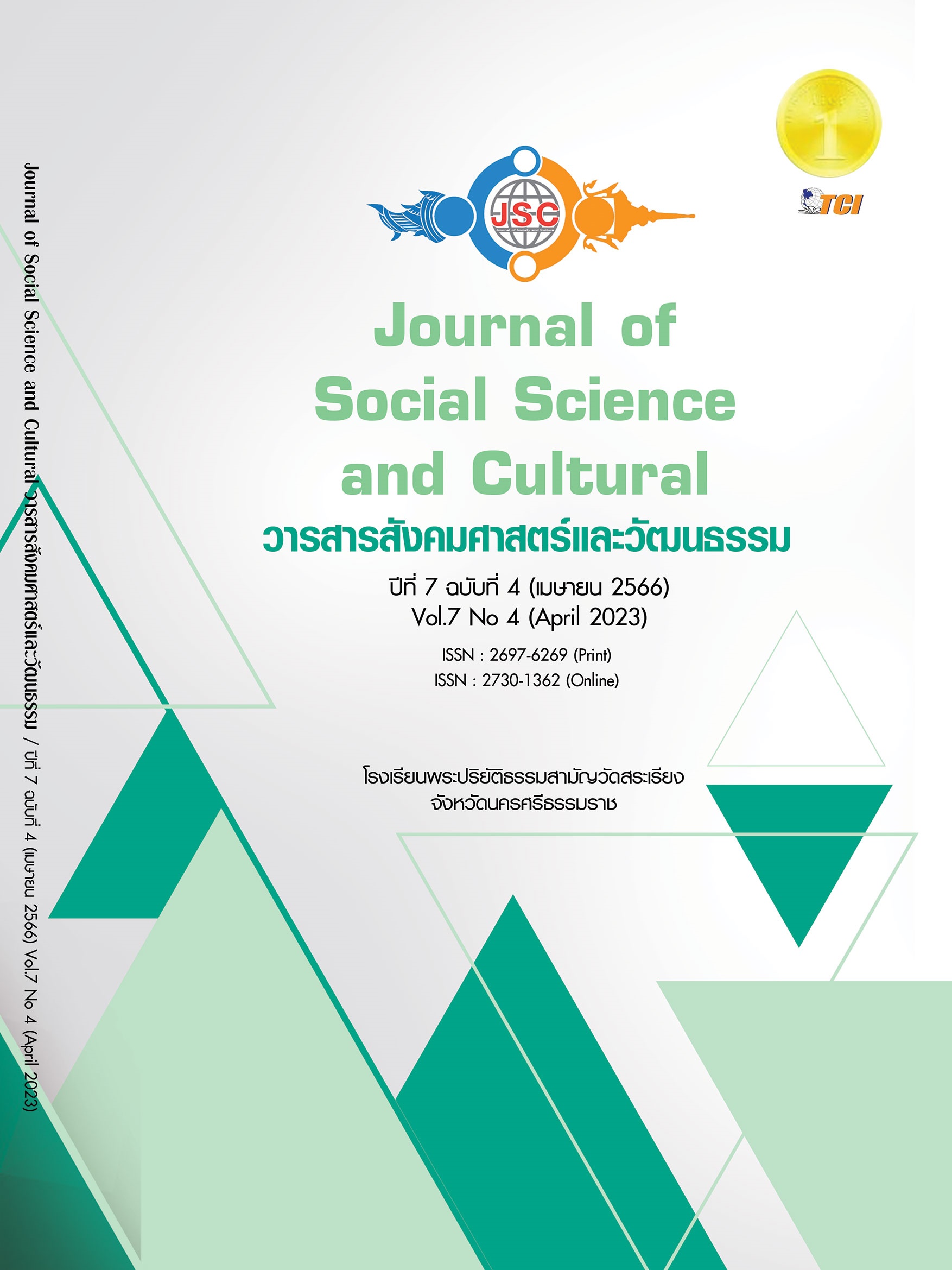ปัจจัยที่ส่งผลต่อการบริหารโรงเรียนอนุบาลเอกชนเขตกรุงเทพมหานคร สู่ความเป็นสถานศึกษาแห่งนวัตกรรม
Main Article Content
บทคัดย่อ
บทความวิจัยนี้มีวัตถุประสงค์เพื่อ 1) ศึกษาสภาพปัจจุบันของความเป็นสถานศึกษาแห่งนวัตกรรม การบริหารโรงเรียนอนุบาลเอกชน 2) ศึกษาปัจจัยที่ส่งผลต่อการบริหารโรงเรียนอนุบาลเอกชน 3) ยืนยันโมเดลความสัมพันธ์เชิงสาเหตุปัจจัยที่ส่งผลต่อการบริหารโรงเรียนอนุบาลเอกชน และ4) วิเคราะห์สมการโครงสร้างโมเดลจำลองปัจจัยที่ส่งผลต่อการบริหารโรงเรียนอนุบาลเอกชน เป็นการวิจัยเชิงปริมาณ กลุ่มตัวอย่าง ได้แก่ บุคลากรที่เกี่ยวข้องกับการบริหารโรงเรียนอนุบาลเอกชนเขตกรุงเทพมหานคร รวมจำนวน 616 คน สุ่มแบบหลายขั้นตอน เครื่องมือที่ใช้วิจัย ได้แก่ แบบสอบถาม ประมาณค่า 5 ระดับ สถิติที่ใช้วิจัย ได้แก่ ความถี่ ร้อยละ ค่าเฉลี่ย ส่วนเบี่ยงเบนมาตรฐาน การวิเคราะห์โมเดลความสัมพันธ์เชิงสาเหตุปัจจัย และจัดทำโมเดลความสัมพันธ์เชิงสาเหตุปัจจัยที่ส่งผลต่อการบริหารโรงเรียนอนุบาลเอกชนเขตกรุงเทพมหานคร สู่ความเป็นสถานศึกษาแห่งนวัตกรรม ผลการวิจัยพบว่า 1) สภาพปัจจุบันความเป็นสถานศึกษาแห่งนวัตกรรมของโรงเรียนอนุบาลเอกชนเขตกรุงเทพมหานครสูงสุด ได้แก่ ด้านการร่วมมือร่วมใจทำงาน ด้านการพัฒนาบุคลากรต่อเนื่อง ด้านการสนับสนุนทรัพยากร ด้านการกำหนดเป้าหมายชัดเจน และด้านผู้บริหารให้การสนับสนุน 2) ปัจจัยที่ส่งผลต่อการบริหารโรงเรียนอนุบาลเอกชน ได้แก่ ปัจจัยด้านวัฒนธรรมสถานศึกษา ด้านการบริหารเชิงกลยุทธ์ ด้านโครงสร้างสถานศึกษา ด้านการพัฒนาทรัพยากรมนุษย์ ด้านการสนับสนุนเครือข่ายภายในและภายนอก ด้านเทคโนโลยี และปัจจัยด้านภาวะผู้นำเชิงนวัตกรรม และ 3) การยืนยันโมเดลความสัมพันธ์เชิงสาเหตุปัจจัยที่ส่งผลต่อการบริหารโรงเรียนอนุบาลเอกชนเขตกรุงเทพมหานคร สู่ความเป็นสถานศึกษาแห่งนวัตกรรม องค์ประกอบเชิงยืนยันโมเดลทุกตัวแปรมีปัจจัยสอดคล้องกับข้อมูลเชิงประจักษ์ และ 4) ผลวิเคราะห์สมการโครงสร้างโมเดลจำลองปัจจัย มีความสอดคล้องของโมเดลจำลองกับข้อมูลเชิงประจักษ์เป็นไปตามเกณฑ์อย่างมีนัยสำคัญทางสถิติที่ระดับ .05
Article Details
เอกสารอ้างอิง
ชวน ภารังกูล. (2556). การศึกษาความเป็นองค์กรนวัตกรรมของสถานศึกษาขั้นพื้นฐาน สังกัดสำนักงานคณะกรรมการการศึกษาขั้นพื้นฐานในจังหวัดราชบุรี. ใน รายงานการวิจัย. มหาวิทยาลัยราชภัฏหมู่บ้านจอมบึง.
ธีระ รุญเจริญ. (2553). ความเป็นมืออาชีพในการจัดการและบริหารการศึกษายุคปฏิรูปการศึกษา (ฉบับปรับปรุง) เพื่อปฏิรูปรอบสองและประเมินภายนอกรอบสาม. (พิมพ์ครั้งที่ 7). กรุงเทพมหานคร: ข้าวฟ่าง.
พงษ์พิพัฒน์ นารินรักษ์. (2566). โมเดลความสัมพันธ์เชิงสาเหตุของปัจจัยที่ส่งผลต่อประสิทธิผลโรงเรียนมาตรฐานสากลในภาคตะวันออกเฉียงเหนือ. วารสารสังคมศาสตร์และวัฒนธรรม, 7(2), 1-19.
พยัต วุฒิรงค์. (2562). การจัดการนวัตกรรมจากแนวคิดสู่การปฏิบัติที่เป็นเลิศ. (พิมพ์ครั้งที่ 2). กรุงเทพมหานคร: โรงพิมพ์แห่งจุฬาลงกรณ์มหาวิทยาลัย.
รัตนะ บัวสนธ์. (2562). การวิจัยและพัฒนานวัตกรรมการศึกษา. (พิมพ์ครั้งที่ 3). พิษณุโลก: สำนักพิมพ์จุฬาลงกรณ์มหาวิทยาลัย.
วิกิพีเดีย สารานุกรมเสรี. (2561). การจัดการความรู้. เรียกใช้เมื่อ 4 มีนาคม 2566 จาก https://th.wikipedia.org/wiki/การจัดการกรอบแนวคิดความรู้.
ศศิประภา ชัยประสิทธิ์. (2553). องค์กรแห่งนวัตกรรม ทางเลือกใหม่ของผู้ประกอบการยุคใหม่. วารสารนักบริหาร มหาวิทยาลัยกรุงเทพ, 30(2), 60-63.
สมนึก เอื้อจิระพงษ์พันธ์. (2553). การจัดการความรู้กับนวัตกรรม. (พิมพ์ครั้งที่ 1). กรุงเทพมหานคร: สามลดา.
สำนักงานคณะกรรมการส่งเสริมการศึกษาเอกชน. (2564). สถิติโรงเรียนเอกชนในระบบ. เรียกใช้เมื่อ 20 พฤศจิกายน 2565 จาก https://opec.go.th.
สิริภักตร์ ศิริโท. (2560). ความเป็นองค์กรนวัตกรรมของสถาบันอุดมศึกษาในประเทศไทย. วารสารบริหารธุรกิจเทคโนโลยีมหานคร, 14(1), 159-177.
สุกัญญา แช่มช้อย. (2562). การบริหารสถานศึกษาในยุคดิจิทัล. (พิมพ์ครั้งที่ 2). กรุงเทพมหานคร: สำนักพิมพ์จุฬาลงกรณ์มหาวิทยาลัย.
องค์อร ประจันต์เขตต์. (2557). องค์กรแห่งนวัตกรรมการศึกษาทางเลือกใหม่ของการบริหารการศึกษา. วารสารพยาบาลทหารบก วิทยาลัยพยาบาลกองทัพบก, 15(1), 45-51.
Adams, B. P. et al. (2006). Innovation management measurement. A Review International Journal of Management Review, 8(1), 21-47.
Damanpour, F. & Schneider, M. (2008). Characteristics of innovation and innovation adoption in public organizations: Assessing the role of managers. Journal of Public Administration Research, 19(3), 495-522.
David, R. P. et al. (2007). Inter-relationships between innovation and market orientation in SMEs. Management Research News, 30(12), 878-891.
Denison, D. R. (1990). Corporate Culture and Organization Effectiveness. New York: Wiley & Sone.
Hay Insight selections. (2005). The innovative organization: Lessons learned from most admired companies. New York: McGraw Hill.
Nadler, L. & Nadler, Z. (1990). The Handbook of Human Resources Development. (2nd ed). New York: John Wiley & Sons Inc.
Parker, G. M. (1990). Team Players and Team Work: The New Competitive Business Strategy. San Francisco, Calif: Jossey - Bass.
Quinn, J. B. (1991). Managing innovation: Controlled chaos. Harvard Business Review, 63(3), 17-28.
Wang, Z. & Zang, Z. (2005). Strategic human resources, innovation and entrepreneurship fit a cross-regional comparative model. International Journal of Manpower, 26(6), 544-559.
Woolner, P. (1992). The purposes and stages of the learning organization. Thresholds in education, 9(2), 4-12.


